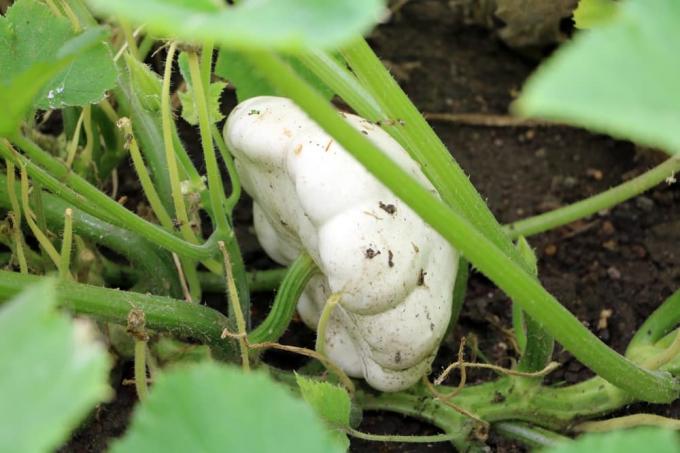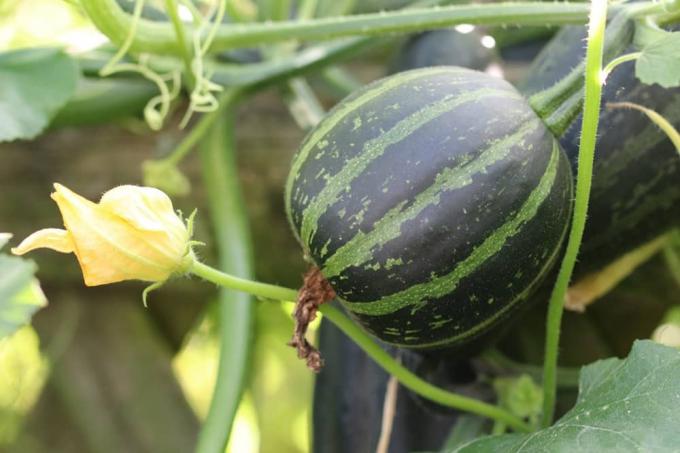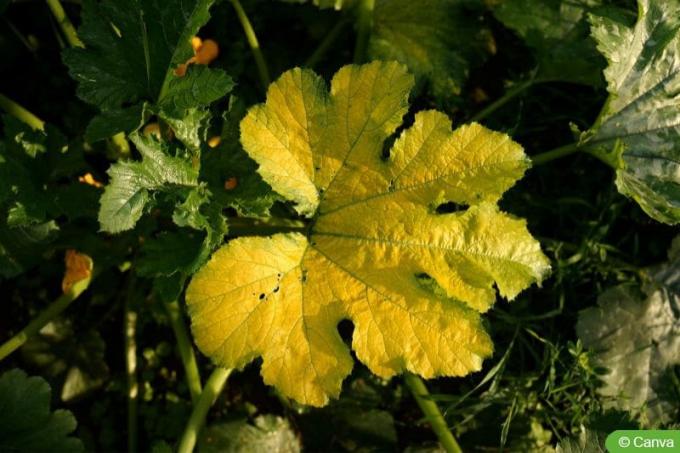

Table of contents
- Hokkaido pumpkin
- Butternut Squash
- nutmeg squash
- Patisson squash
- Spaghetti Squash
- Yellow hundredweight
- Buttercup Squash
- Baby Bear
- Jack be Little
- sweet dumplings
- Turkish turban/bishop's hat
With more than 800 pumpkin varieties, it is difficult to keep track of which of them are edible and enjoyable as pumpkins. So everyone knows the Hokkaido or the butternut squash. But there are also many other varieties that can be used in the kitchen and are very tasty. The following list is intended to provide information about which types of pumpkin are still suitable for the kitchen.
Hokkaido pumpkin

The Hokkaido squash is also known under the name Potimarron, chestnut or onion squash. It is one of the giant pumpkin varieties and is the tastiest and therefore the most used pumpkin for a wide variety of dishes. When the fruits weigh around one to two kilograms, they are ready for processing. The Hokkaido possesses the following characteristics:
- bright orange color
- Its shape is reminiscent of large onions
- the peel can be boiled and consumed
- fine aroma of sweet chestnuts
- can be prepared as a casserole, tart or soup
- also tastes fried or baked
- the flavor increases when the skin is cooked with it
Tip:
The Hokkaido squash is the most named squash in the many recipes circulating on various sites on the internet. This is mainly due to the fact that the preparation is so easy, since it is very soft overall and does not have to be peeled.
Butternut Squash
The butternut squash is easily recognized by its pear-shaped appearance. When it weighs about one to two kilos, it is ready for use in the kitchen. Since the variety has very few seeds, it provides more pulp. It also has the following properties:
- belongs to the musk gourd family
- smells faintly of musk after cutting
- can be eaten raw or cooked
- has a delicate aroma of butter
- green, unripe fruits taste better
- cream to brown when ripe
- needs warm, humid climate to grow
- grow in greenhouses in local latitudes
Tip:
As a rule, most late pumpkin varieties can be stored for a long time in a dark and not too warm, dry place. For this, however, the shell must be undamaged. Summer squash, on the other hand, can also be frozen after processing.
nutmeg squash
The nutmeg pumpkin, or Muscade de Provence, is a very large variety of pumpkin. The fruit can reach a weight of up to 20 kilos. The pumpkin is also quickly recognized by its distinctive appearance due to the many ribs. The tasty pumpkin variety is often prepared as a pure vegetable, but also for fillings. The nutmeg pumpkin also has the following properties:
- very aromatic and juicy
- can be prepared both raw and cooked
- Color between dark green to light brown
- Flesh between yellow and orange-red
- undemanding in care
- Can be stored for a long time after harvest
- slightly sour nutmeg note
- particularly suitable for exotic dishes
- belongs to the musk gourd family
- can be eaten with skin if cooked for a long time
Tip:
A ripe pumpkin, of any variety, can be identified by its hollow sound when tapped.
Patisson squash

The shape of the Patisson pumpkin is reminiscent of a UFO. It is available in different colors between white, yellow, green or two-tone. The fruit is quite small with a diameter of 10 to 25 centimeters and can therefore also be cultivated in a bucket on the terrace or balcony. Unfortunately, the variety is not suitable for long storage and should therefore be processed as soon as possible after harvesting. For longer storage, however, the Patisson is very suitable for pickling. In addition, it has the following properties:
- Can be eaten raw or whole with skin
- can be well filled and cooked in the oven
- other names Courgette, Squash or Ufo
- are harvested with a weight of 500 grams to one kilo
Tip:
In the past, pumpkins were considered “poor people’s food” and were mostly used as cattle feed, but fortunately this has changed today. Because all pumpkin varieties are very healthy and contain many valuable minerals and vitamins. These include calcium, potassium and zinc as well as vitamins A, C, D and E.
Spaghetti Squash
The spaghetti squash owes its name to its fibrous flesh, which is reminiscent of spaghetti, especially after cooking or baking. The fruits weigh up to two kilograms and have an oval-elongated to rounded shape. The color of the shell varies between cream and sun yellow. He has the following properties:
- can be cooked with the skin on
- then cut in half and scoop out the flesh
- still quite unknown variety in local latitudes
- originally comes from Asia
- warm, humid climate preferred
- Cultivation Ideally in a greenhouse
- Appearance reminiscent of a honeydew melon
Tip:
The spaghetti squash does not require much to prepare. It is simply cooked whole and seasoned with pepper and salt and Parmesan before consumption. It is well suited as an accompaniment to meat dishes.
Yellow hundredweight
The yellow or giant hundredweight is a round, large giant pumpkin. It can weigh up to 50 kilos and is therefore often bred by amateur gardeners for a record. But it is also very tasty and is therefore often chosen for various food preparations. This giant pumpkin, which belongs to the same family as the Hokkaido pumpkin, also has the following properties:
- is particularly suitable for desserts
- will be hollowed out on Halloween
- orange skin and yellow flesh
- The peel is theoretically edible
- however, is very hard and is therefore removed
Buttercup Squash

The buttercup is a small, round pumpkin that, like the Turkish turban, also has a cap-like attachment. The skin is dark green with the flesh being orange. The buttercup squash, which is still little known in the local latitudes, has the following properties:
- very hard shell
- not suitable for consuming
- peeling is very difficult
- so better hollow it out
- Bowl can be used as a bowl at the table
- can be baked, eaten in a casserole or soup
Baby Bear
The Baby Bear is a very small variety with a diameter of ten centimeters when the fruit is ripe. The grooved, dark orange peel makes the fruit look very decorative. Therefore, the variety is also very suitable for cultivation in a bucket on the balcony or terrace. The Baby Bear also has the following properties:
- used for desserts or soups
- very hard shell
- should be peeled before consumption
- the pulp is yellow
Jack be Little
One of the very decorative pumpkins is the Jack be Little, which only has small fruits that usually only weigh between 150 and 300 grams. Since this type of pumpkin is one of the mini garden pumpkins, it is also often offered in stores as an edible ornamental pumpkin. So Jack be Little still has the following properties:
- also very tasty raw
- orange, firm flesh
- Flavor of sweet chestnuts when cooked
- can be used in many dishes
- in salads, soups, casseroles
Anyone who cultivates a Jack be Little in the garden can look forward to the decorative fruits over the summer until they are harvested for the kitchen in autumn. Since the fruits are not very large and heavy, the variety is also suitable for cultivation in a bucket on the balcony or terrace.
sweet dumplings
The Sweet Dumpling originally comes from Mexico and is also known under the name Patidou. The small fruits are ripe when they weigh between 300 and 600 grams. In contrast to many other types of pumpkin, the Sweet Dumpling, as the name suggests, tastes very sweet and has a chestnut aroma. In addition, this variety has the following properties:
- can be cooked whole
- firm, crunchy flesh, even after cooking
- The color of the shell is reminiscent of ornamental gourds
- yellow with rich green stripes
Due to the small, decorative fruits, the sweet dumpling can also be cultivated on the balcony or terrace.
Turkish turban/bishop's hat

This type of pumpkin is known by two names, it is available either as a Turkish turban or as a bishop's hat. The reason for the names is clear from the appearance of the fruit. Because this is very unusual and is indeed reminiscent of a turban. This is due to the fact that during growth the base of the flower remains as a ring, around which a different colored and bulging pulp then forms. In addition, the Turkish turban has the following properties:
- very difficult to cut due to the shape
- medium-round and flat with an attachment reminiscent of a hat
- is therefore often used as a soup bowl
- scoop out the flesh with a spoon and prepare it
- then pour it back into the bowl as a soup
- has a decorative side effect on the table
- Fruit weighs between one and two kilos
- Shell not edible
Tip:
If you work according to the recipe, you will find quantities for the pumpkin pulp to be used here. So it can be assumed that a kilo of whole pumpkin offers about 600 to 700 grams of pure pulp that can be used.
 garden editorial
garden editorial I write about everything that interests me in my garden.
Learn more about pumpkins

Zucchini fruits rot on the plant: what to do?
Sometimes a young zucchini fruit suddenly stops growing. At the same time it becomes yellow and rotten from the top. Read here how you can save your harvest if the fruits of your zucchini are rotting on the plant.

Harvesting butternut squash: when is it ripe?
Rich yellow flesh and a pear-like shape characterize the butternut squash. If you have enough space for the fast-growing plants, you will be rewarded with many tasty fruits. When is the butternut squash ready for harvest?

Yellow leaves on zucchini: what to do?
Zucchini planted in the garden usually develop so luxuriantly that there is often a veritable glut of zucchini. However, if the zucchini gets yellow leaves, you should consider location, care and diseases as causes and act immediately.

Zucchini: remove male flowers?
Zucchini form female and male flowers on one plant. The male flowers are important for pollination and thus fruit formation. The question often arises as to what the advantages and disadvantages are after removing the flowers.

15 good neighbors of pumpkin | mixed culture
The cultivation of pumpkins is effectively supported by the right mixed culture. Good neighbors protect against pests, can be used as a natural climbing aid and optimize the nutrient balance in the bed. Pumpkins can be cultivated much more successfully this way.

Grow your own luffa cucumber 9 tips for the sponge gourd
Although the luffa cucumber comes from the tropics, it can also be grown locally. However, the sponge gourd is dependent on certain conditions when it comes to location and care, with these tips you will have a rich harvest.
